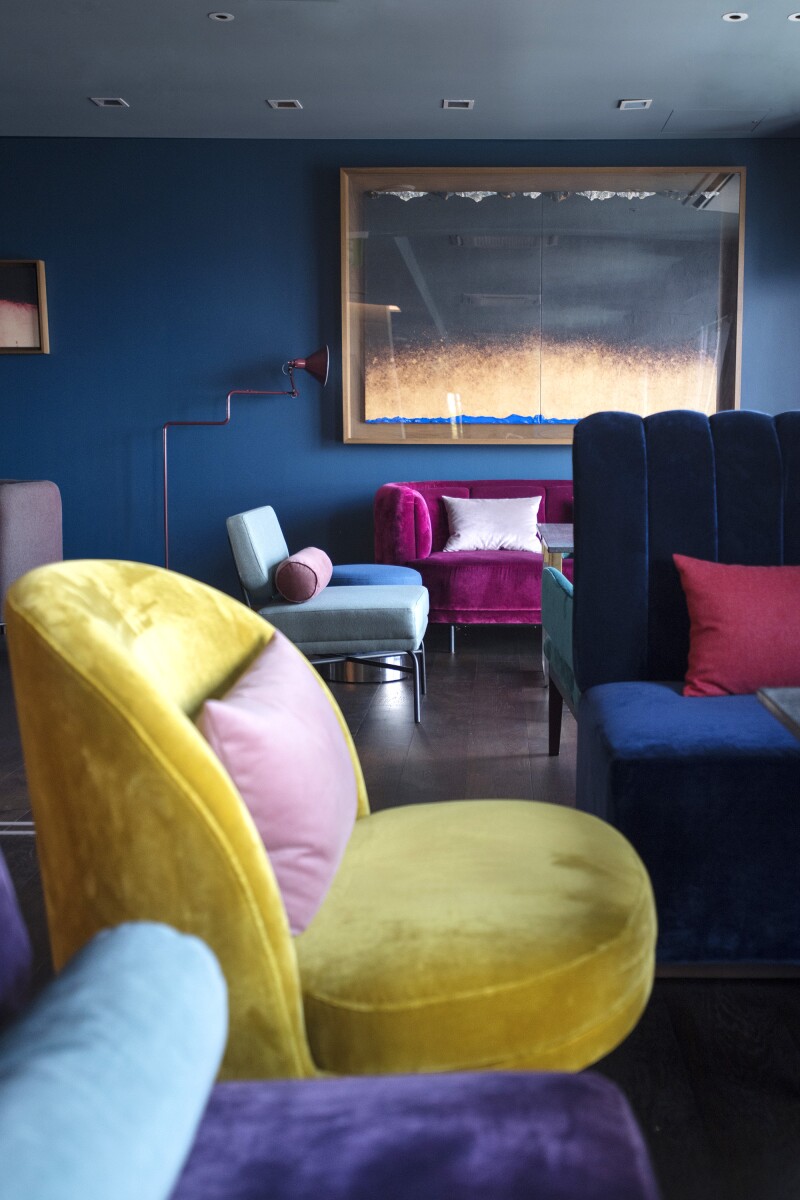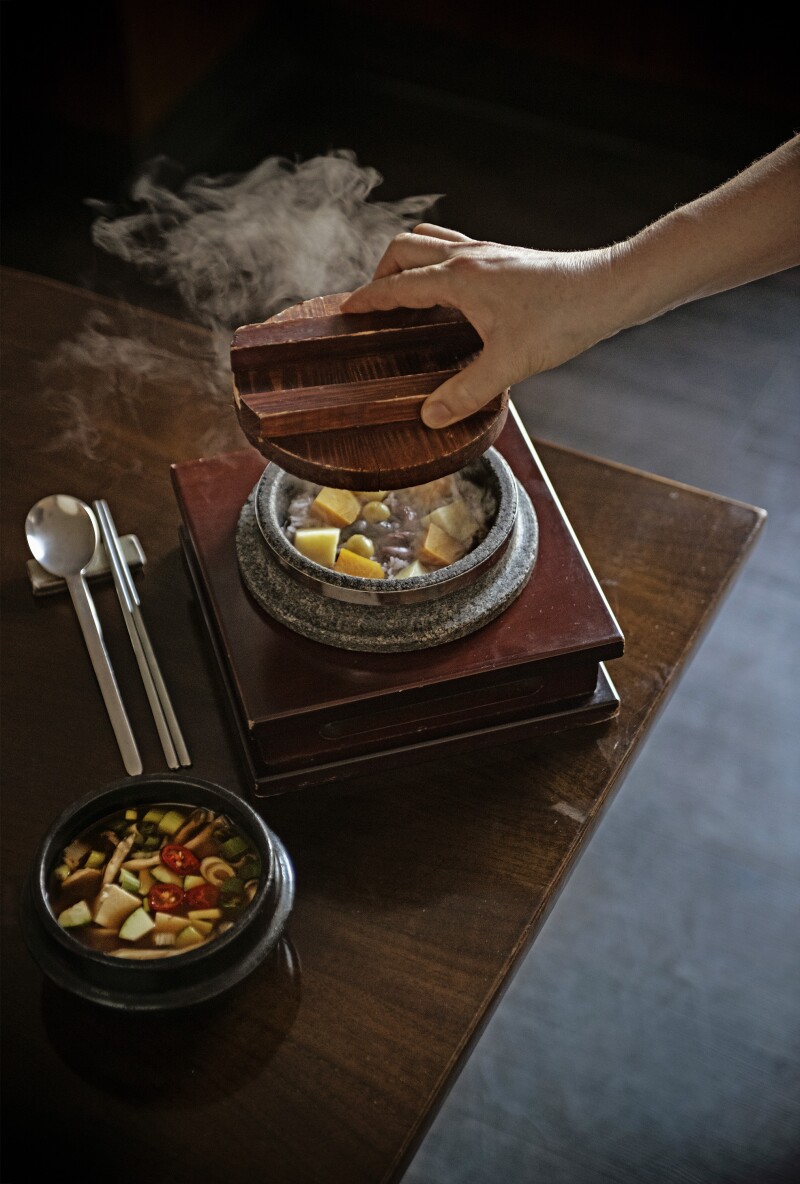I was born and raised in Jeonju, a city famous for traditional Korean cuisine. Our region had plenty of clean, flowing water and access to high-quality ingredients. And because my immediate family was responsible for our relatives’ ancestral rites, we prepared big family dinners more than 10 times a year.
My mom was a very good cook, and my dad worked for a global trading company. He’d bring home baking tools from all over the world, which my mom would experiment with in the kitchen. Whenever she cooked, I helped out.

Pastry chef Hyunhee Lee helms the first Tartine outpost in Seoul, a wood-paneled space in the Hannam Dong district. “The country bread with apple butter is my absolute favorite,” she says.
Photo by Chiara Goia
When I entered middle school, I started baking simple things for myself as a hobby. At that time, there weren’t any recipe books or even blogs I could turn to. My sister, who was studying abroad, would mail me cookbooks. I cooked for myself until I entered university. I majored in computer science and got a job as a programmer at a bank. I worked for three years before realizing I needed to change careers. That’s when I circled back to my first love: cooking.
I thought about opening a café, but I needed to learn more. So in 2006 I moved to France in to attend Le Cordon Bleu [the famed cooking school]. I decided to specialize in pastries because the process is more mathematical. My plan was to spend five years in France and then move back to Korea, this time to Seoul, to open a shop. At that moment, there were few small, independently owned spots. Artisanal desserts hardly existed. I could only find Japanese-style chiffon cakes, cheesecakes, and sponge cakes. There was a big gap in the landscape.
In 2011, I opened a business called Dessert Tree in Seoul’s Apgujeong district. We only served desserts—we even offered a tasting menu—and the concept caught on quickly, because I was doing something different. At that point, Koreans made no distinction between desserts and bread (some people still don’t). Bread, desserts, and cakes are all viewed as bread. And only things displayed in glass cases were considered dessert. I wanted to break this misconception.

The RYSE Hotel includes an experimental art gallery and cocktail bar.
Photo by Chiara Goia
At Dessert Tree, I didn’t have display cases. Instead, my menus had pictures of the desserts, which I’d assemble in front of guests once the order was taken. The names of my creations sounded classic, but when you saw and tasted them, you would realize that they were special. My crème brûlée, for example, was flavored with passion fruit and banana, then topped with a berry sorbet and almond crumble.
On the side, I was consulting for bakeries and cafés, including Tartine, the San Francisco bakery started by Chad Robertson and Elisabeth Prueitt—he’s the modern-day champion of rustic, artisanal bread, she’s the champion of rustic pastries. Eventually, Tartine decided to open a few branches in Seoul, and needed someone with a baking background who was also familiar with its brand. [The first location opened in the Hannam district in 2018.] There were some challenges. Since we wanted to make the pastries and bread consistent with what’s sold in San Francisco, we had to import all our flours. I had to make sure everything stayed authentic to the Tartine vision, because people here want to experience what they would in the United States. But we also wanted the bread and pastries to reflect Korean culture. I had to track down local ingredients to bake with, and select the right ones to match locals’ tastes. For one cake, I use Korean green tea. We also use yuja (a Korean citrus fruit) and black sesame. Last autumn, I created a pie with Korean pumpkins.
I had to make sure everything stayed authentic to the Tartine brand, because people here want to experience what they would in San Francisco. Before Tartine came to Seoul, there were more bakeries owned by French bakers—but not by American bakers. More and more local bakeries now consider Chad and Elisabeth’s books to be baking bibles. They’re so popular, they’ve been translated into Korean.

Lee recommends the Berliner, a German brioche filled with marmalade or custard, at Fritz Coffee Company.
Photo by Chiara Goia
Ryse Hotel
“You can spend an entire day at this hip hotel in the youthful, arty neighborhood of Hongdae. The Arario Gallery in the hotel shows lots of experimental art, and the Side Note Club offers cocktails inspired by different topics, like the season—their Summer cocktail has rum, agave, and citrus and pineapple juices. Plus, there’s a Tartine outlet on-site.”
Fritz Coffee Company
“This trendy spot reminds me of visiting a childhood friend’s home because of its traditional-looking interiors. You can even drip your own coffee, with the help of the baristas. Be sure to try the Berliner, a German brioche filled with marmalade or custard.”
Tartine Bakery Seoul
“For those who want to eat the best bread and croissants in Korea, this is the place. It really helped change locals’ notions of American baking. Try one of the breads with butter. The country bread, a sourdough, with spiced apple butter is my absolute favorite.”
Studio Concrete
“A gallery and café in Itaewon, near many of the embassies, Studio Concrete was founded by a famous Korean actor, Yoo Ah-in, and some friends. It’s in a renovated house from the 1980s. Despite the rough-looking exterior, everything inside is warm and neatly organized. I like to check out the free cultural and art events. When the weather is breezy, head up to the roof to enjoy tea.”

The Hyundai Card Cooking Library provides cooking resources, such as chef-led classes and more than 10,000 culinary books residents can borrow.
CHIARA GOIA
Keumok-Dang Café
“A café named for keumok-dang, a traditional snack typically made with adzuki beans and sugar. It’s heavier than Western jelly pudding and smoother than caramel. The color, texture, and shape resemble a rich, fudgy brownie. It makes the perfect gift for foreign friends who enjoy sweets.”
Binari Café
“If you’re into home goods and eating, visit this lifestyle shop in the Yeonhui neighborhood. I like to pick up vegetable chips for snacking later. There’s also a kitchen where different chefs host unique themed dinners, such as “Maja Kitchen,” a pop-up that offered Spanish dishes.”
Naeil Sikdang Restaurant
“The small, modest restaurant serves Japanese, Chinese, and Korean home-style cooking. Everything is simple and delicious. I recommend the eggplant rice and tonkatsu (Japanese fried pork cutlets). After dinner, take a walk through Seonyudo Park.”
Balwoo Gongyang
“Because it serves Korean temple food, meat and alcohol are not offered here. Instead, you’ll drink a special pine-needle tea that is naturally relaxing. I love to bring important guests to Balwoo. The servers are so soft and gentle, as if they were monks, and are great at explaining the menu in English.”

Binari Café, located in the Yeonhui neighborhood, offers food and home goods.
CHIARA GOIA
Seoul Vinyl
“A tiny, softly lit neighborhood bar in Haebangchon that plays only records. I like visiting, especially on a rainy day. The best seat is at the bar in front of the DJ. You’ll find mostly gin-based drinks, like the Monkey 47 Tonic. A lot of foreigners like to hang out here. If you’re lucky enough, you may spot a well-known musician having cocktails: It’s a favorite of the famous singer J.Y. Park.”
Queenmama Market
“I come to this multilevel store near glitzy Dosan Park to escape the city. The park view from the Manufact Coffee shop on the fourth floor makes you feel like you’re in a forest. The first and second floors are gardening and lifestyle shops, and the third floor is a bookstore. It’s a great place to find peace on a busy day.”
Boan 1942
“Located in the Boan buildings—an old motel that’s been renovated—Boan 1942 is a hotel, gallery, bookstore, and café. It has a professional tea sommelier and serves assorted Korean teas along with snacks. I recommend walking around the neighborhood afterward and checking out some of the local galleries.”
Hyundai Card Cooking Library
“Located across from the Queenmama Market, the space provides cooking resources for foodies: chef-led classes and more than 10,000 culinary books residents can borrow. The library is only open to Hyundai Card holders, but the shop, deli, bakery, and café are all open to the public.”
>>Next: Hot Korean Street Foods to Warm Your Cold, Cold Seoul











